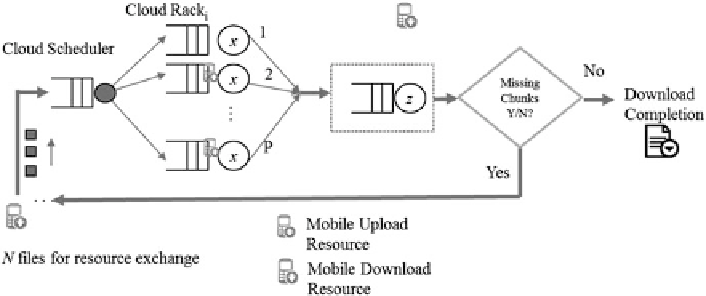Image Processing Reference
In-Depth Information
Fig. 7.3 Resource partitioning and scheduling model
In Fig.
7.3
, a closed queuing processing cloud model is considered that consists of P
parallel heterogeneous processor-enabled devices and the I/O subsystem. All het-
erogeneous processors share a single queue (memory), whereas the multi-migrate-
resume policy is used for switching incomplete claims, to another cloud terminal—
if the available resources of a terminal cannot complete the requests. The effects of
the memory requirements and the communication latencies are explicitly
represented in the closed queuing-processing cloud model. Moreover, these evalu-
ations appear at the job/claim execution time. The z subsystem in Fig.
7.3
, which is
hosted on the MNi consists of mechanism that reassembles all the file chunks that
were portioned, into a single module, modeled as a single I/O node with a given
mean service time based on the characteristic of the device.
To aid clarity, this work considers that every resource may be an executable file
x
, which consists of
t
x
partitioning tasks where 1
z*
P,
where
z
is the number
of different racks. Therefore, the number of tasks per file is limited to the number of
rack terminals in the system. An executable resource or—as called—task can be
shared and partitioned to
x
1
,
x
2
,
t
x
x
n
and can be simultaneously processed with
...
s
sequential partitions, where 0
s
<
z*P
, if and only if the following relation
holds:
X
n
s
þ
pxðÞ
z
P
ð
7
:
3
Þ
i
¼
1
where
p
(
x
) represents the number of cloud terminals that are needed to host the
a
j
.
The scheduling strategy that was used is based on the largest first served/shortest
sequential resource first served and the service notations of [
25
] with a-priori
knowledge of the [
S
t
,
P
d
] service durations.
From the rack failure perspective, this work elaborates on the examination of the
impact of a possible overload in the case of rack failure/crash. When a rack failure
occurs, it will directly affect several applications based on dependability and the
characteristics of the rack synthesis. The resource allocation will take place in order

